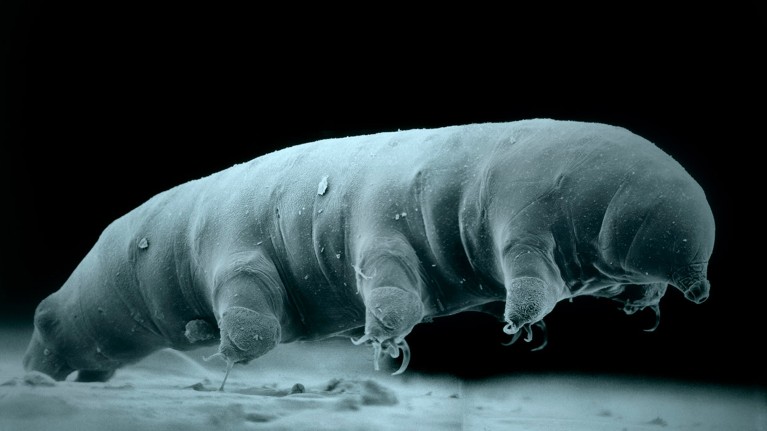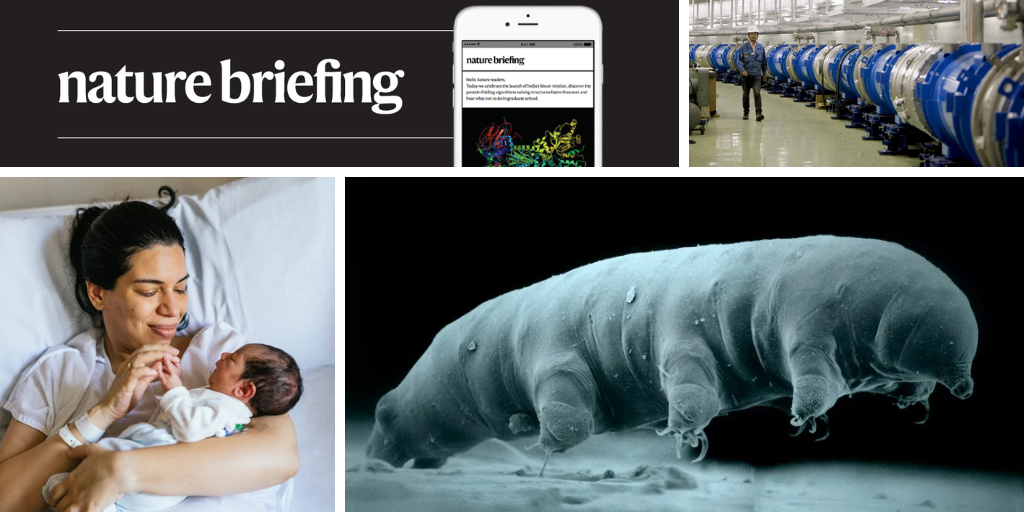Hello Nature readers, would you like to get this Briefing in your inbox free every day? Sign up here.

The new species is similar in appearance to this Hypsibius sp. tardigrade, photographed using an electron microscope.Credit: Robert Schuster/Science Photo Library
A newly described species of tardigrade (Hypsibius henanensis) is giving scientists insights into what makes these tiny eight-legged creatures so resistant to radiation. Scientists sequenced the genome of this new species and identified thousands of genes that become more active when exposed to radiation. These processes point to a sophisticated defence system that involves protecting DNA from the damage that radiation causes and repairing any breaks that do occur. They hope that these insights could be harnessed to protect humans exposed to radiation during space missions or to improve cancer treatment.
Feeding a baby born by caesarean section milk containing a tiny bit of their mother’s poo introduces beneficial microbes to their gut. In early results of a clinical trial, poo samples showed there was a marked difference between the microbial diversity of babies who were fed 3.5 milligrams of their mother’s poo in milk and those who received a placebo. While the results are positive, researchers emphasize that this method should not be replicated at home. “You have to be certain that the faecal matter that you give to the newborn doesn’t include pathogens that could cause a disease,” says Otto Helve, paediatrician and the study’s primary investigator.
Researchers have accelerated muons — the heavier, unstable cousins of electrons — into a tightly controlled beam for the first time. A team at the Japan Proton Accelerator Research Complex in Tokai shot a laser at a stream of muons to bring the fast-moving particles to a near-standstill. Then, the researchers applied an electric field to accelerate these ‘cooled’ muons to around 4% of the speed of light. The feat takes researchers a step closer to making a muon collider, which would be smaller and cheaper than other current colliders, a reality.
Reference: arXiv preprint (not peer reviewed)
Features & opinion
Molecular palaeontologist Alexandra Morton-Hayward investigates why a small proportion of ancient brains somehow resist the decomposition process that begins to destroy most soft tissue within hours after death. Her motivation for studying the brain goes beyond scientific curiosity. She is a former mortician, and she suffers from a rare brain abnormality and daily cluster headaches: extremely painful attacks that led her to attempt suicide. “I’m always aware of my brain,” she says. “Sometimes, it feels like it’s in worse shape than the ones I have on the bench in the lab.”
A government agent tracks a genetic anomaly through the marshland in the latest short story for Nature’s Futures series.
Five specialists share essential books for understanding threats to democracy past and present, including an exploration of how diverging perspectives on who should be able to vote and how have shaped voting rights and elections in the United States since the colonial era and a sweeping perspective on how technology — from mobile phones to artificial intelligence — has shaped geopolitics.
The scale of two ancient cities buried high in the mountains of Uzbekistan has been uncovered using drone-mounted laser technology. One of the cities was six times bigger than expected. The two cities, called Tashbulak and Tugunbulak, were nestled in the heart of Central Asia’s medieval Silk Road, suggesting that highland areas played an important role in trade of the era. “It’s not a village, it’s urbanized, because it has its own citadel where the rulers lived,” says archaeologist Farhod Maksudov. “We think it was some kind of mountain civilization very independent politically and economically from the huge Empires which were down there in the lowlands.”
Nature Podcast | 30 min listen
Subscribe to the Nature Podcast on Apple Podcasts, Spotify or YouTube Music, or use the RSS feed.
Today Leif Penguinson is exploring the Itaimbezinho, a canyon in the Aparados de Serra National Park, Brazil. Can you find the penguin?
The answer will be in Monday’s e-mail, all thanks to Briefing photo editor and penguin wrangler Tom Houghton.
Tomorrow I’ll be sitting down to watch The Terminator as the sci-fi classic turns 40. By the film’s timeline, we’re only a few years away from a future in which SkyNet sends the titular killing machine back to the 80s. Here’s hoping those events stay confined to fiction.
Help us shape the future of this newsletter by sending your feedback to [email protected].
I’ll be back next week.
Jacob Smith, associate editor, Nature Briefing
Want more? Sign up to our other free Nature Briefing newsletters:
• Nature Briefing: Careers — insights, advice and award-winning journalism to help you optimize your working life
• Nature Briefing: Microbiology — the most abundant living entities on our planet — microorganisms — and the role they play in health, the environment and food systems
• Nature Briefing: Anthropocene — climate change, biodiversity, sustainability and geoengineering
• Nature Briefing: AI & Robotics — 100% written by humans, of course
• Nature Briefing: Cancer — a weekly newsletter written with cancer researchers in mind
• Nature Briefing: Translational Research — covers biotechnology, drug discovery and pharma


